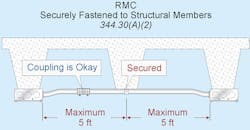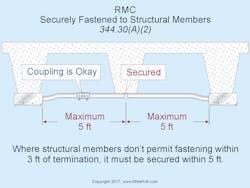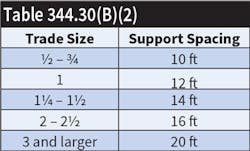All questions and answers are based on the 2020 NEC.
Q. What is the NEC requirement for securing and supporting rigid metal conduit (RMC)?
A. RMC must be installed as a complete system in accordance with Sec. 300.18 [300.10 and 300.12], and it must be securely fastened in place and supported in accordance with Sec. 344.30(A) and (B). Here’s a summary of those basic requirements.
(A) RMC must be secured in accordance with any of the following:
(1) Fastened within 3 ft of each outlet box, junction box, device box, cabinet, conduit body, or other conduit termination. Fastening is required within 3 ft of terminations, not within 3 ft of each coupling.
(2) When structural members don’t permit the raceway to be secured within 3 ft of a box or termination fitting, the raceway must be secured within 5 ft of the termination (Figure).
(3) Conduits aren’t required to be securely fastened within 3 ft of the service head for an above-the-roof termination of a mast.
(B) RMC must be supported as follows:
(1) General. RMC must be supported at intervals not exceeding 10 ft.
(2) Straight Horizontal Runs. Straight horizontal runs made with threaded couplings can be supported in accordance with the distances contained in Table 344.30(B)(2).
(3) Vertical Risers. Exposed vertical risers for fixed equipment can be supported at intervals not exceeding 20 ft, if the conduit is made up with threaded couplings, firmly supported, securely fastened at the top and bottom of the riser, and if no other means of support is available.
(4) Horizontal Runs. Conduits installed horizontally in bored or punched holes in wood or metal framing members, or notches in wooden members, are considered supported, but the raceway must be secured within 3 ft of termination.
Rigid metal conduit must be provided with expansion fittings if necessary to compensate for thermal expansion and contraction [Sec. 300.7(B)]. The expansion characteristics for metal raceways are determined by multiplying the values from Table 352.44 by 0.20, and the expansion characteristics for aluminum raceways is determined by multiplying the values from Table 352.44 by 0.40 [Sec. 300.7 Note].
Q. What are the Code requirements for couplings and connectors installed in rigid metal conduit runs?
A. Threadless couplings and connectors must be made up tight to maintain an effective ground-fault current path to safely conduct fault current in accordance with Secs. 250.4(A)(5), 250.96(A) and 300.10 [344.42]. Loose locknuts have been found to burn clear before a fault was cleared because loose connections increase the impedance of the ground-fault current path.
If buried in masonry or concrete, threadless fittings must be the concrete-tight type. If installed in wet locations, fittings must be listed for use in wet locations and prevent moisture or water from entering or accumulating within the enclosure in accordance with Sec. 314.15.
Threadless couplings and connectors aren’t permitted to be used on threaded conduit ends, unless listed for the purpose.
Running threads aren’t permitted for the connection of couplings, but they’re permitted at other locations.
These materials are provided to us by Mike Holt Enterprises in Leesburg, Fla. To view Code training materials offered by this company, visit www.mikeholt.com/code.
About the Author

Mike Holt
Mike Holt is the owner of Mike Holt Enterprises (www.MikeHolt.com), one of the largest electrical publishers in the United States. He earned a master's degree in the Business Administration Program (MBA) from the University of Miami. He earned his reputation as a National Electrical Code (NEC) expert by working his way up through the electrical trade. Formally a construction editor for two different trade publications, Mike started his career as an apprentice electrician and eventually became a master electrician, an electrical inspector, a contractor, and an educator. Mike has taught more than 1,000 classes on 30 different electrical-related subjects — ranging from alarm installations to exam preparation and voltage drop calculations. He continues to produce seminars, videos, books, and online training for the trade as well as contribute monthly Code content to EC&M magazine.



